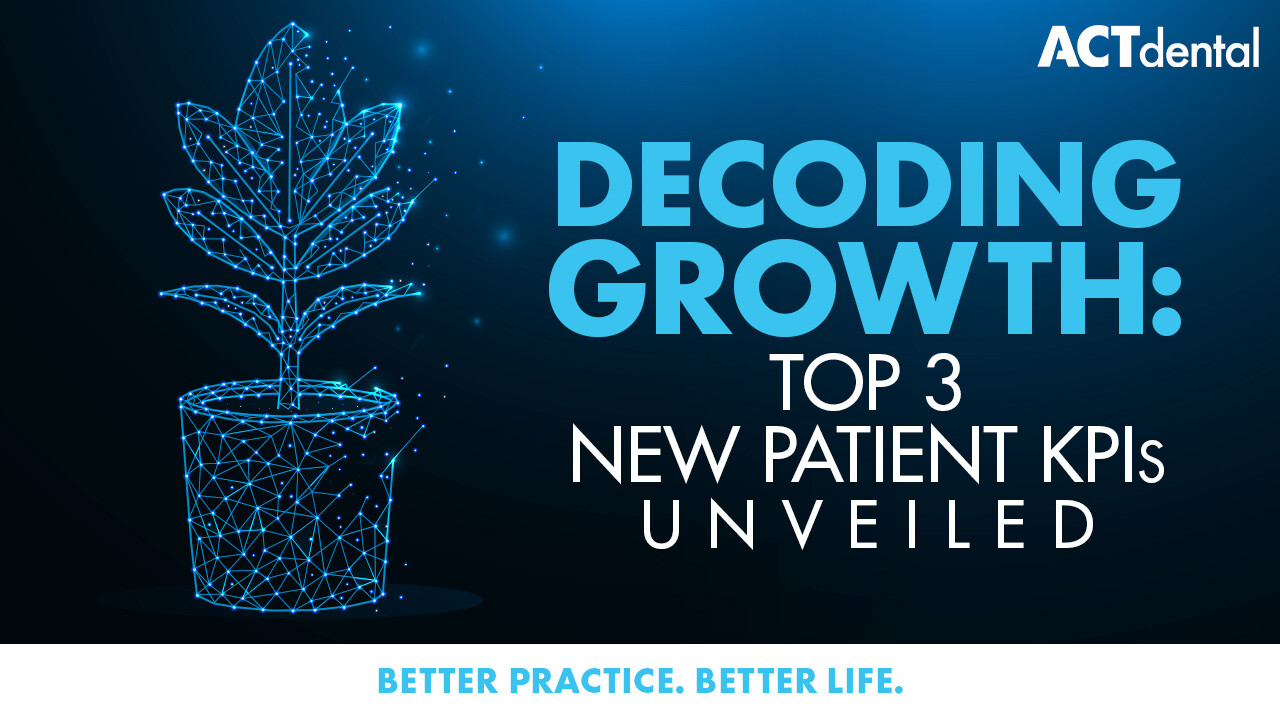New patients are the bread and butter that keep your practice rolling, but you can’t just take on all of them. You need the right amount of the right patients, but how do you know where you stand? The answer is data. We love data here, because data is honest. Like Kirk says, “data has no emotion,” it just presents the facts and tells a story. In this case it tells the story of how many new patients per month join the practice, but also how many of those new patients will return. With that knowledge, you can identify what you do well, but also what you need to improve.
To tell the story of your new patient experience, start monitoring and understanding these three metrics:
- New Patient Count
According to Dental Intel, this metric includes the number of patients who have had a first completed visit in the practice—as soon as an ADA code is walked out on the ledger, they become a new patient. You have to start somewhere, and this is one of the easiest metrics to manage. Every practice is different, so you want to create individual goals for the number of new patients you want to introduce on a monthly basis. You need to be strategic, so consider these tips:
- The sooner you schedule new patients, the better! Schedule them within two weeks.
- Reserve time blocks in your schedule for new patients, ensuring you have enough blocks to support your new patient goal.
Note: Your practice management software may have a different definition of a New Patient, such as accounting for any newly created patient account. Ensure you understand the software you are using to track data.
- New Patient Net Growth
In Dental Intel, this metric refers to the number of New Patients and Recaptured Patients minus the number of Lost Patients, and it’s absolutely critical to measure it. Remember, Lost means they haven’t completed a visit in the last 18 months or have been Inactivated in your software, while Recaptured means they hadn’t completed a visit in the last 18 months, but have now done so. Why is this so important? If you have 100 New Patients each month, but have 150 going Inactive each month, then you’re in a patient deficit and need to plug that leaky bucket! Try making your follow-up systems more consistent, which will help you recapture more patients and improve your new patient net growth rates.
- New Patient Hygiene Reappointment Percentage
The number of new patients you gain is only as important as how many plan to return. Dental Intel defines the New Patient Hygiene Reappointment metric as the percentage of New Patients with a future hygiene appointment. Hygiene is such an important department in the practice, because it’s where loyalty lives, so ensuring you schedule your new patients to establish future commitment is essential. These are some tips and strategies that I recommend that will help you do so:
- Ask them to schedule their next hygiene visit, get their commitment.
- If a patient has urgent needs, schedule two appointments—one for their restorative needs, and one for the future hygiene visit.
- Even if you’re referring a new patient to a specialist, still schedule a future visit.
Improving these metrics means tracking them, first and foremost, and then working to create an experience that will keep your new patients coming back. When it comes to creating success for your new patients, the new patient experience is everything! To help you on this journey, download this tool that will help you create a 6-Star Experience for your patients.
As always, you don’t have to—and should not—do this on your own. Reach out to Gina to learn more about ACT and how we can help you build a Better Practice, and a Better Life!
Tune in next time and learn about one of the most important aspects of any business: Core Values!
Miranda Beeson, MS, BSDH
Miranda Beeson, MS, BSDH, has over 25 years of clinical dental hygiene, front office, practice administration, and speaking experience. She is enthusiastic about communication and loves helping others find the power that words can bring to their patient interactions and practice dynamics. As a Lead Practice Coach, she is driven to create opportunities to find value in experiences and cultivate new approaches. Miranda graduated from Old Dominion University and enjoys spending time with her husband, Chuck, and her children, Trent, Mallory, and Cassidy. Family time is the best time and is often spent on a golf course, a volleyball court, or spending the day boating at the beach.
RECENT POSTS
Your Words Shape Your Momentum - Choose Wisely
January 05, 2026
991: Metric Mondays: Overhead – Lab Percentage – Robyn Theisen
January 05, 2026
The Three Roles That Define Dental Practice Success
January 02, 2026
990: Hiring the Wrong People? You Might Be Missing This One Crucial Step – Carlie Einarson
January 02, 2026
989: Master the Metrics – Simple Data, Big Impact – Robyn Theisen
December 31, 2025
988: Metric Mondays: Overhead – Facilities and Equipment Percentage – Robyn Theisen
December 29, 2025
987: Core Values Aren't Fluff — They're Your Practice’s Greatest Asset – Heather Crockett
December 26, 2025
986: Security in AI for Your Dental Practice – Travis Wentworth
December 24, 2025
We Lit Up The Year 2025
December 22, 2025
985: Metric Mondays: Overhead – Operations Percentage – Miranda Beeson
December 22, 2025

